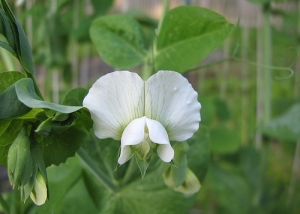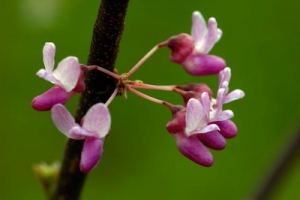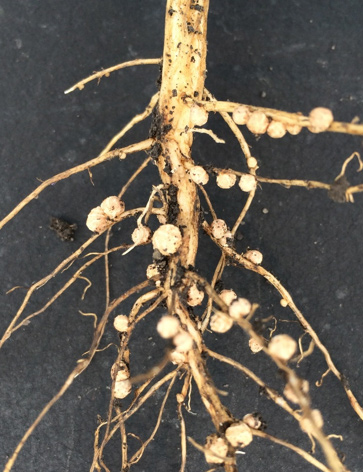Fixing Nitrogen When It’s Not Broken
By Molly O’Boyle, Fairfax Master Gardener
If you grow a vegetable garden, you may have heard that some plants “fix” nitrogen. What does it mean to you as a gardener, and how can you “fix” your own nitrogen?

Garden Pea Flower
There is an abundance of inert N2, nitrogen gas, in the soil and the atmosphere. Surprisingly, nitrogen gas is unusable to plants and animals. Nitrogen is, however, readily available in the form of NH3 (ammonia) which can be used to manufacture amino acids, proteins, nucleic acids and other nitrogen-containing components necessary for life.
Commercial fertilizers have three main nutrient components for plant growth: N-P-K — nitrogen, phosphorus and potassium/potash. Nitrogen is used by plants for quick, vegetative growth. Phosphorus is used by the plant to produce flowers and vegetables. Potassium is used for root growth. Phosphorus and potassium will be retained in the soil for use by the plants, whereas nitrogen quickly turns into a gas and is available to the plants for only a short time.

Cercis canadensis flowers
When a plant is said to go through a process called biological nitrogen fixation (BNF), that means the plant is able to hold onto nitrogen in the soil to aid in the growth of that plant. Legume plants, such as beans, peas, peanuts, soybeans/edamame and clover, are by far the most prevalent nitrogen-fixing plants. Plant scientists have long studied the symbiotic relationship between legumes and rhizobia bacteria because the legumes are the largest family of plants to have this symbiotic relationship.
Rhizobia bacteria are plentiful in the soil. They penetrate the root tissue of legumes by creating a structure called a nodule. The bacteria then live in the nodules and break down the nitrogen gas into ammonia for the plant to use in its growth and fruit production. The legume plant is healthier with these good bacteria, and the bacteria thrive when attached to the plant. Truly ingenious!
If you were to pull up a growing bean plant, you would see nodules within 2 to 3 weeks of planting. An interior pinkish color means the nodule is actively fixing nitrogen in the soil. The pink or red color is caused by leghemoglobin (similar to hemoglobin in blood) that controls oxygen flow to the bacteria and keeps them alive.

Edamame (soybean) root nodules
Nodules are short-lived and will be replaced by more as the growing season moves on. Once the fruit is maturing on the legume plant, the plant sends its energy to the fruit, so the nodules begin to die off at that time. The number of nodules in the root system varies by plant variety. Beans can have up to 100 per plant, soybeans can have a couple hundred per plant, and peanuts can have thousands per plant.
Farmers used to plant peas, then corn and, finally, peas again in the fall — all in the same field. I am going to practice this exact process in my vegetable garden this year — peas, corn, peas. I hope to have an excellent harvest with all three seasons in the same garden box.
In addition to cultivated legumes from the Fabaceae plant family, there are many other legume plants in the U.S. You may know these wild plants by their flowers or their fruit pods; the black locust tree, redbud tree (Cercis canadensis), lupine, vetch, alfalfa and kudzu, for example.
Keep your eyes open this year to see just how many plants in your neighborhood are actually legumes.
References
• Vegetables, Fruit, Whole Grains, and Beans, University of North Carolina
• Nitrogen Fixation by Legumes, New Mexico State University, Guide A-129, College of Agricultural,
Consumer and Environmental Sciences
…updated 2023